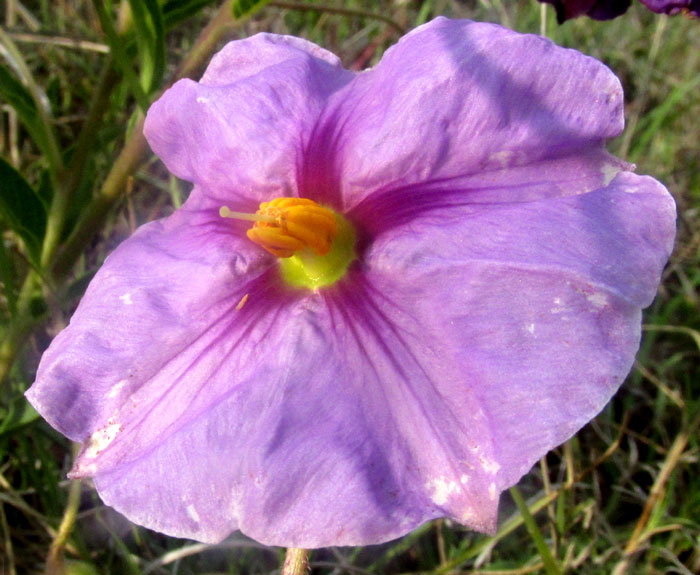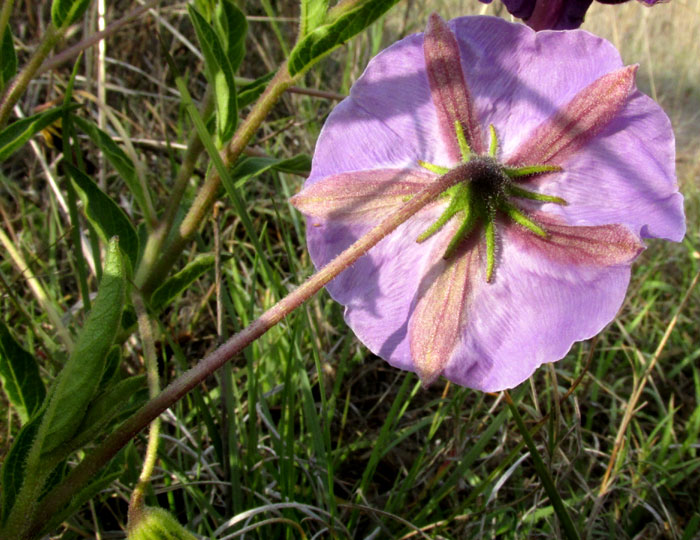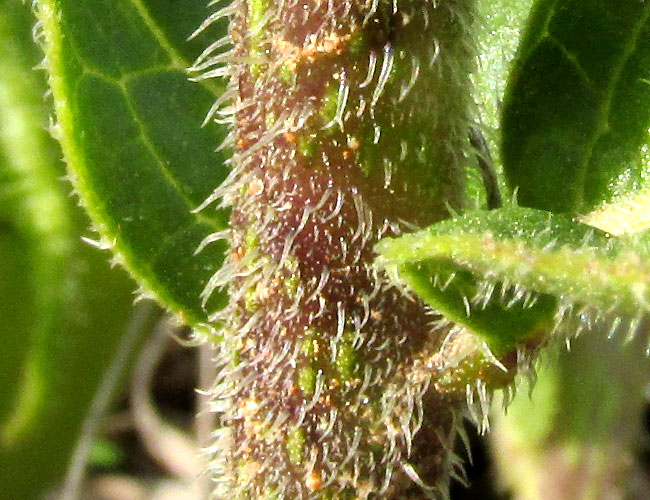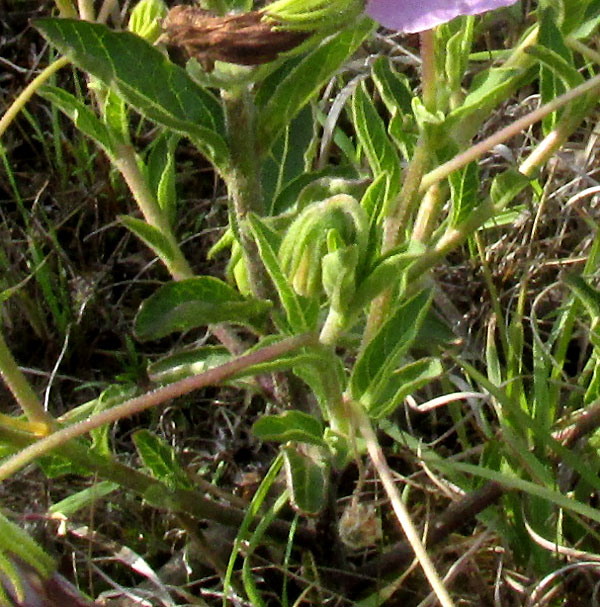Excerpts from Jim Conrad's
Naturalist Newsletter
entry from field notes dated July 2, 2022, taken on the eastern lower slope of Cerro de la Cruz, at an elevation of ~2700m (~8850 ft), just south of the community of El Pinar, Amealco de Bonfil, Querétaro, MÉXICO, (~N20.17°, ~W100.17°)
TLANOXTLE FLOWERING

On the lower eastern slope of Cerro de la Cruz, in a large abandoned field covered mostly with scattered shrubs and clumpgrass, the above wildflowers were a big surprise. The rainy season, usually arriving in May, was weeks late and the field grass was parched gray and crunchy, but a small colony of this plant looked as if it were watered each day. The blossoms, about 30mm across, (1¼ inch), slightly nodded their faces atop unusually long pedicels, and all faced away from the morning sun, as if warming the backs of their heads, with the fronts of their corollas glowing from the back-lighting. I tipped a flower upward to better expose the face:

The flower's five stamens were of different lengths, slightly nodding as were the flowers themselves. The stamens' orange-yellow, pollen-producing anthers opened at their tops with small pores from which pollen would be expelled when bees vibrated them -- "buzz pollination." From the center of the grouped stamens a slender, pale style emerged tipped with a knobby stigma.

From the back, the long, straight pedicel was impressive, but more important to notice for identification purposes was that the green calyx divided into ten appendages, not five.

The vegetative parts were hairy, and the stems were rough with stiff, broad-based hairs nodding downward like the flowers and their stamens. This plant just has a nodding predisposition.

The stems branched readily, and the leaves were rather narrow and with short petioles.
Gardeners and those who appreciate wildflowers may instantly recognize this plant as a member of the big Nightshade/Potato/Tomato Family, the Solanaceae. Moreover the widely spreading corolla with a shallow, funnel-like center, and the anthers tipped with pores, not splitting along their sides, is just like flowers of potato and tomato plants, which are members of the large genus Solanum. However, wild Solanum species produce calyxes with five calyx lobes, and our flowers had ten. Here we had something else: It was the genus Lycianthes.
The 200 or so species of Lycianthes are mostly tropical American, with 53 known species occurring in Mexico and Guatemala, and about nine in our upland central Mexico region known as the Bajío. In our area, any wild, upright-standing Lycianthes species that's non-woody, has a round-faced corolla instead of a star-faced one, unbranched hairs, and flower pedicels longer than the leaves below them is LYCIANTHES MOZINIANA.
Lycianthes moziniana is endemic just to higher elevations in central Mexico south to Oaxaca. It's known by many names, but for some reason both English and Spanish literature often calls it Tlanoxtle, the Náhuatl or ancient Aztec name.
Tlanoxtle may be the best known of Lycianthes species because earlier it was an important food crop. David E. Williams in his 1993 study entitled "Lycianthes moziniana (Solanaceae): An Underutilized Mexican Food Plant with 'New' Crop Potential" tells us that Tlanoxtle's main occurrence in along the high-elevation belt of volcanoes running east and west across central Mexico, and that other populations of it are disjunct, or island populations apart from the main one. This suggests that ancient people took the plant to their home areas and tended it, where is survives today, sometimes protected by traditional farmers.
By the way, Williams also describes how, of the flower's five stamens, four release their pollen before the fifth. On this fifth stamen the filament elongates so the pore at the anther's tip comes close to the flower's own stigma. He suggests that this may be a self-pollination mechanism.
Tlanoxtle fruits are juicy, sweet, slightly tart or acid tasting, similar to the closely related tomato, which are nutritious and good to eat. Usually they're eaten raw but sometimes they're dried and stored, or boiled in sugar syrup and canned to make preserves. They're roundish or oval, up to 4.15 cm in diameter (nearly 1⅔ inch).
In one field of barley, Williams reports, he found Tlanoxtle plants growing at a density of 4700 plants per hectare (2.5 acres). The plants averaged 30 fruits per plant, thus providing a calculated 1.25 metric tons (2756 pounds) of fruit per hectare. This was a crop alongside the barley, and didn't appear to affect the barley's production.
Williams also observed that Tlanoxtle fruits often play part in Mexico's Day of the Dead festivals, one of the oldest and most important religious festivals in Mexico. During the week or so of the festival, material offerings that loved dead ones enjoyed in life, such as food, drink, cigarettes and such, are placed on an alter for the pleasure of the dead person's wandering spirit. Tlanoxtle fruits often have been offered. Sometimes they're sold in traditional markets, their long pedicels braided with others to hold clumps of fruits together, similar to how sometimes garlic and onion plants are prepared to hang up for drying.
Maybe the most interesting of William's insights is that taking into account all the facts his study generated, he was inclined to think that maybe the plants we find today in places such as our abandoned field are not just wild or semi-wild plants that somehow have survived alongside disappearing traditional farming practices. They may be the "vestigial remnant of an ancient crop," and they are "in clear danger of extinction as changes in agricultural attitudes and technology are rapidly eliminating the traditional agroecosystems upon which the survival of its populations depends."
And those remarks were published in 1993.